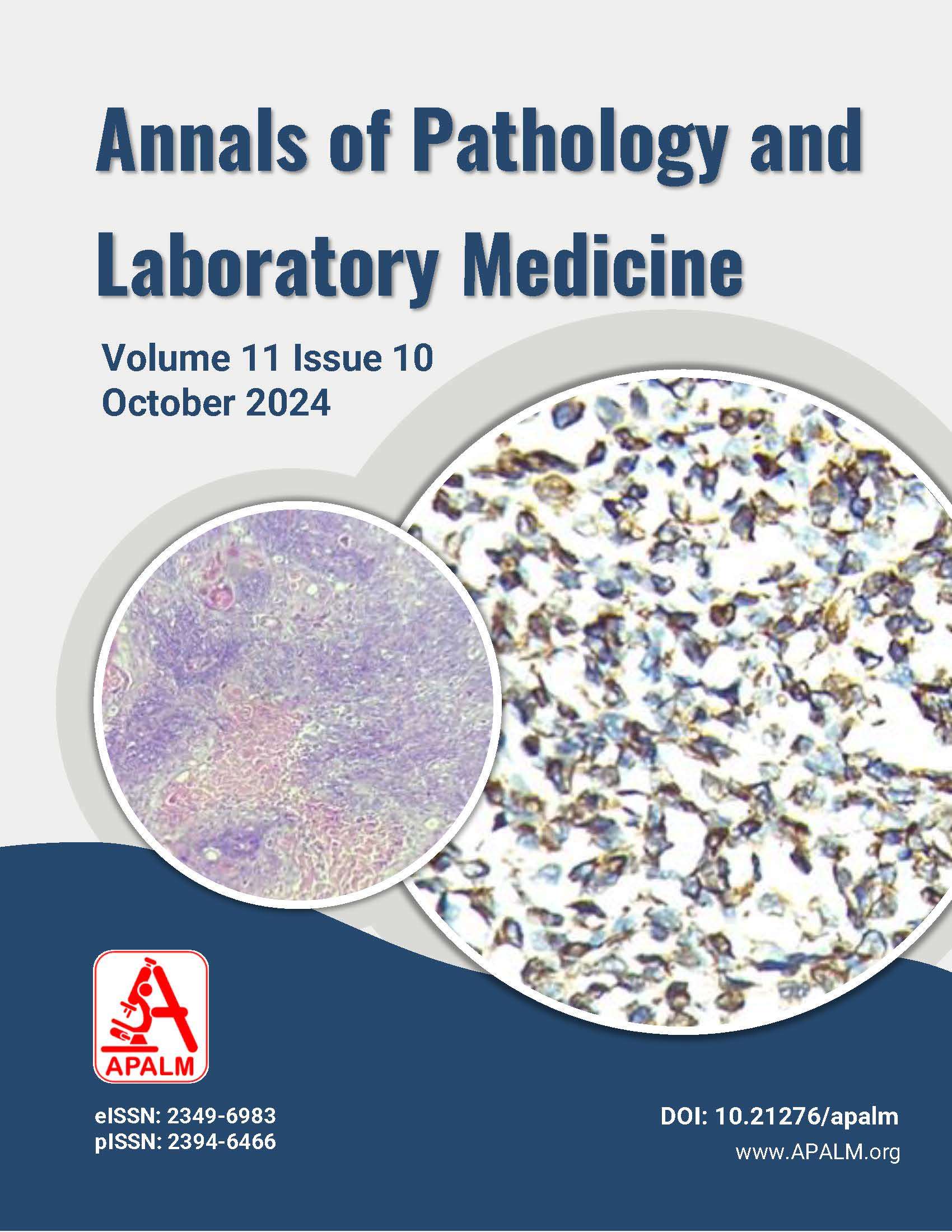A Study of Clinico-Pathological Characteristics of Endometrial Carcinoma with Respect to Grading
DOI:
https://doi.org/10.21276/apalm.3385Keywords:
Endometrial Carcinoma, Radical Hysterectomy, Tumour Grading, FIGO StagingAbstract
Background: Endometrial cancer is an emerging health concern in India, largely affecting postmenopausal women due to lifestyle changes and demographic factors. This study aims to analyze the clinicopathological characteristics of EC in Indian patients to improve diagnosis, prevention, and treatment.
Materials and Methods: This retrospective study included 50 patients who underwent radical hysterectomy for EC at a tertiary care center over six years. Data was collected on demographic and tumor characteristics and clinical outcomes, including age, parity, menopausal status, tumor type, FIGO grade, stage, size, myometrial invasion, lymphovascular invasion, and lymph node metastasis. Statistical analysis determined the significance of these factors in prognosis and survival.
Results: The mean age at diagnosis was 62 years, with 86% of patients being postmenopausal. The most common type was endometrioid carcinoma (82%). Significant prognostic factors included tumor size, myometrial invasion, lymphovascular invasion, lymph node status, and FIGO staging. High-grade tumors exhibited a higher incidence of lymphovascular invasion (80% vs. 42.5%, p-value = 0.033) and poorer survival outcomes (50% vs. 81.3% alive, p = 0.049). FIGO staging, lymph node metastasis, and lymphovascular invasion were statistically significantly correlated with mortality.
Conclusion: EC primarily affects postmenopausal women, with endometrioid carcinoma being the most common type. Prognostic factors such as tumor size, myometrial invasion, lymphovascular invasion, and lymph node status influence treatment decisions and patient outcomes. High-grade tumors are associated with more aggressive disease and worse survival rates, highlighting the importance of thorough nodal evaluation and tailored treatment approaches. This study enhances the understanding of EC, aiding in the development of improved diagnostic and management strategies.
References
2. Yasin HK, Taylor AH, Ayakannu T. A narrative review of the role of diet and lifestyle factors in the development and prevention of endometrial cancer. Cancers (Basel). 2021 Apr 29;13(9):2149.
3. Singh N, Hirschowitz L, Zaino R, Alvarado-Cabrero I, Duggan MA, Ali-Fehmi R, Euscher E, Hecht JL, Horn LC, Ioffe O, Matias-Guiu X, McCluggage WG, Mikami Y, Ordi J, Parkash V, Quddus MR, Quick CM, Staebler A, Zaloudek C, Nucci M, et al. Pathologic prognostic factors in EC (other than tumor type and grade). Int J Gynecol Pathol. 2019;38 Suppl 1:S93—S113.
4. Gouthaman S, Saravanan R, Maharajan S, et al. Clinicopathological analysis of carcinoma endometrium at a tertiary care centre in Chennai — a retrospective study. J Evid Based Med Healthc. 2021;8(29):2625-2632.
5. Angadi V et al. Int J Res Med Sci. 2022 Sep;10(9):1925-1929
6. Vidal F, Rafii A. Lymph node assessment in endometrial cancer: towards personalized medicine. Obstet Gynecol Int. 2013:1—8
7. Hou X, Yue S, Liu J, Qiu Z, Xie L, Huang X, Li S, Hu L, Wu J. Association of tumor size with prognosis in patients with resectable endometrial cancer: a SEER database analysis. Front Oncol. 2022;12:887157.
8. Iskandar TM, Putra VGE, Ambari E, Cahyono E, Lubena. Clinicopathological characteristics and possible risk factors for extrauterine metastases in endometrial carcinoma. Bali Med J. 2022;11(3):1410-1414.
9. Jezan HS, Kutb MA. Histopathological variations of endometrial cancer. Int J Sci Healthc Res. 2019;4(4):10-12
10. Goel G, Rajanbabu A, Sandhya CJ, et al. A prospective observational study evaluating the accuracy of MRI in predicting the extent of disease in endometrial cancer. Indian J Surg Oncol. 2019;10:220—224.
11. Ueno Y, Yoshida E, Nojiri S, et al. Use of clinical variables for preoperative prediction of lymph node metastasis in endometrial cancer. Jpn J Clin Oncol. 2024;54(1):38-46.
12. Dane C, Bakir S. The effect of myometrial invasion on prognostic factors and survival analysis in endometrial carcinoma. Afr Health Sci. 2019;19(4):3235-3241.
Downloads
Published
Issue
Section
License
Copyright (c) 2024 Dr. Raval Chhabra, Dr. Prem S Patel, Dr. Aishani Tiwari, Dr Anupama Dayal, Dr. Divyesh N Panchal

This work is licensed under a Creative Commons Attribution 4.0 International License.
Authors who publish with this journal agree to the following terms:
- Authors retain copyright and grant the journal right of first publication with the work simultaneously licensed under a Creative Commons Attribution License that allows others to share the work with an acknowledgement of the work's authorship and initial publication in this journal.
- Authors are able to enter into separate, additional contractual arrangements for the non-exclusive distribution of the journal's published version of the work (e.g., post it to an institutional repository or publish it in a book), with an acknowledgement of its initial publication in this journal.
- Authors are permitted and encouraged to post their work online (e.g., in institutional repositories or on their website) prior to and during the submission process, as it can lead to productive exchanges, as well as earlier and greater citation of published work (See The Effect of Open Access at http://opcit.eprints.org/oacitation-biblio.html).










